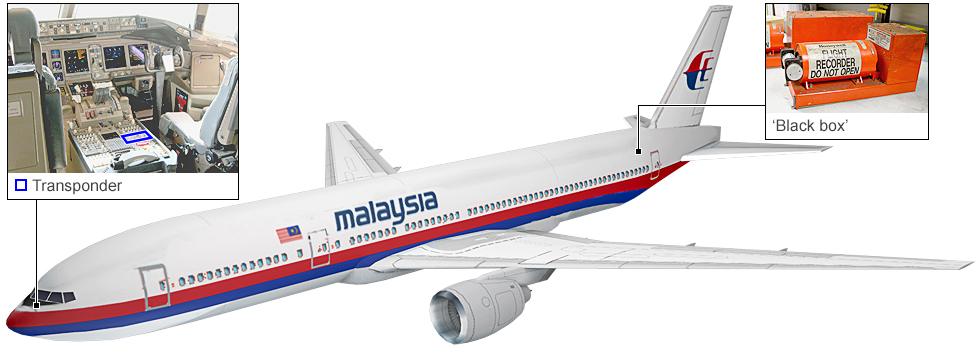Missing Malaysia plane MH370: What we know
- Published
The Malaysian government has officially declared the disappearance of Malaysian Airlines flight MH370, en route from Kuala Lumpur to Beijing on 8 March 2014, an accident.
Despite an extensive international search in the southern Indian Ocean, no trace of the aircraft has been found. Officials confirmed that the recovery operation was ongoing but that the 239 people onboard are now presumed dead.
Since the end of June, investigators carrying out the search have been focusing on a refined area covering 60,000 sq km 1,800km (1,100 miles) off the west coast of Australia.

Based on analysis of satellite data, the plane is believed to have ended its journey in seas far west of the Australian city of Perth.
The search zone is some 1,000km south west of the area which was extensively searched with underwater surveying equipment in April.
Following a deep water survey gathering crucial data mapping the ocean floor that begun in August, four vessels are currently searching a remote stretch of ocean where the plane is believed to have ended its flight.
Using specialised sonar technology, the vessels can scan for the missing plane.
So far, an area of over 18,000 km sq (11,185 sq miles) of the seafloor - around 30 per cent of the priority area - has been searched.
The search area involved also has known depths of up to 6,000 m (19 685 ft).
According to the Australian Transport Safety Bureau (ATSB), the current phase of the underwater investigation could be largely completed by around May.
Watch the video below to find out about the jet's last known movements.
Missing jet timeline
00:41, 8 March: Malaysia Airlines Flight MH370 departed from Kuala Lumpur International Airport on Saturday, 8 March (16:41 GMT, 7 March), and was due to arrive in Beijing at 06:30 (22:30 GMT).
Malaysia Airlines says the plane lost contact less than an hour after takeoff. No distress signal or message was sent.
01:07: The plane sent its last ACARS transmission - a service that allows computers aboard the plane to "talk" to computers on the ground. Some time afterwards, it was silenced and the expected 01:37 transmission was not sent.
Flight MH370: Audio recording reveals final cockpit communications
01:19: The last communication between the plane and Malaysian air traffic control took place about 12 minutes later. At first, the airline said initial investigations revealed the co-pilot had said "All right, good night".
However, Malaysian authorities later confirmed the last words heard from the plane, spoken either by the pilot or co-pilot, were in fact "Good night Malaysian three seven zero".
A few minutes later, the plane's transponder, which communicates with ground radar, was shut down as the aircraft crossed from Malaysian air traffic control into Vietnamese airspace over the South China Sea.
01:21: The Civil Aviation Authority of Vietnam said the plane failed to check in as scheduled with air traffic control in Ho Chi Minh City.
02:15: Malaysian military radar plotted Flight MH370 at a point south of Phuket island in the Strait of Malacca, west of its last known location. Thai military radar logs also confirmed that the plane turned west and then north over the Andaman sea.
In maps accompanying its 1 May report, the Malaysian government revised the time to be 02:22 and put the position further west, external.
02:28: (18:28 GMT, 8 March) After the loss of radar, a satellite above the Indian Ocean picked up data from the plane in the form of seven automatic "handshakes" between the aircraft and a ground station. The first was at 02:28 local time.

08:11: (00:11 GMT) The last full handshake was at 08:11. This information, disclosed a week after the plane's disappearance, suggested the jet was in one of two flight corridors, one stretching north between Thailand and Kazakhstan, the other south between Indonesia and the southern Indian Ocean.
08:19: (00:19 GMT) However, there is some evidence of a further "partial handshake" at this time between the plane and a ground station. This was a request from the aircraft to to log on. Investigators say this is consistent with the plane's satellite communication equipment powering up after an outage - such as after an interruption to its electrical supply., external
09:15: (01:15 GMT) This would have been the next scheduled automatic contact between the ground station and the plane but there was no response from the aircraft.
What happened next?
The plane's planned route would have taken it north-eastwards, over Cambodia and Vietnam, and the initial search focused on the South China Sea, south of Vietnam's Ca Mau peninsula.
But evidence from a military radar, revealed later, suggested the plane had suddenly changed from its northerly course to head west. So the search, involving dozens of ships and planes, then switched to the sea west of Malaysia.
Further evidence revealed on Saturday 15 March by the Malaysian Prime Minister Najib Razak suggested the jet was deliberately diverted by someone on board about an hour after takeoff.
After MH370's last communication with a satellite was disclosed, a week after the plane's disappearance, the search was expanded dramatically to nearly three million square miles, from Kazakhstan in the north to vast areas of the remote southern Indian Ocean.

Then, on 20 March, Australian search teams revealed they were investigating two objects spotted on satellite images in the southern Indian Ocean and sent long-range surveillance planes to the area, followed by further sightings. An Australian ship and further vessels travelled to the area.
At 1400 GMT on 24 March the Malaysian prime minister announced that following further analysis of satellite data it was beyond doubt that the plane had gone down in this part of the ocean.
This was based on Inmarsat and UK air accident investigators' analysis of the data relayed between the plane and ground station by satellite.
More potential debris was spotted by satellites but on 28 March the main search area was moved 1,100km (684 miles) to the north-east and closer to Australia, following further analysis of the speed of the plane and its maximum range.
Malaysian officials said that the debris could still be consistent with the new search area as ocean currents may have moved floating objects. However, no debris has yet been verified as being from the plane.
On 5-8 April, Australian and Chinese vessels using underwater listening equipment detected ultrasonic signals, which officials believed could be from the plane's "black box" flight recorders. The pings appeared to be the most promising lead so far, and were used to define the area of a sea-floor search, conducted by the Bluefin-21 submersible robot.
But Australian officials announced on 29 May that the search had found nothing and the area where the signals were heard could be ruled out as the final resting place of the plane. Efforts would now focus on reviewing data, surveying the sea floor and bringing in specialist equipment, the Joint Agency Co-ordination Centre (JACC) said, external.
Meanwhile, Malaysian authorities, assisted by international aviation and satellite experts, continue their attempts to piece together the plane's final hours and explain what happened to its 239 passengers and crew.
Australian officials believe the plane was flying on autopilot when it crashed.
On 26 June, officials announced a new 60,000 sq km search area some 1,800 km west of Perth. This phase of the operation started in August with detailed mapping of the sea bed.

Teams searching for wreckage of the plane have used specialist equipment to survey the ocean floor, enabling a metre-by-metre underwater search relying on towed instruments and submersibles.
In August, Australia's Deputy Prime Minister Warren Truss said that areas on the southern part of the refined search field in the Indian Ocean were "of particular interest and priority".
Fugro Survey, the Dutch company contracted by the Australian authorities to lead the deep sea investigation, said that the search could take up to twelve months.

Who was on board?

Muhammad Razahan Zamani (bottom right), 24, and his wife Norli Akmar Hamid, 33, were on their honeymoon on the missing flight. The phone is being held by his stepsister, Arni Marlina
The 12 crew members were all Malaysian, led by pilots Captain Zaharie Ahmed Shah, 53 and 27-year-old co-pilot Fariq Abdul Hamid.
Police have searched their homes and a flight simulator has been taken from the captain's home and reassembled for examination at police headquarters.
There were 227 passengers, external, including 153 Chinese and 38 Malaysians, according to the manifest, external. Seven were children.
Other passengers came from Iran, the US, Canada, Indonesia, Australia, India, France, New Zealand, Ukraine, Russia, Taiwan and the Netherlands.
Two Iranian men were found to be travelling on false passports. But further investigation revealed 19-year-old Pouria Nour Mohammad Mehrdad and Delavar Seyed Mohammadreza, 29 were headed for Europe via Beijing, and had no apparent links to terrorist groups.
Among the Chinese nationals was a delegation of 19 prominent artists, who had attended an exhibition in Kuala Lumpur.
Malaysia Airlines said there were four passengers who checked in for the flight but did not show up at the airport.
The family members of those on board were informed in person, by phone and by text message on 24 March that the plane had been lost.
The declaration that the aircraft's disappearance was an accident should allow compensation payments to relatives of the victims.